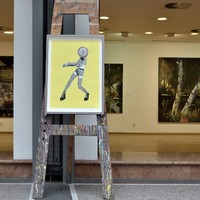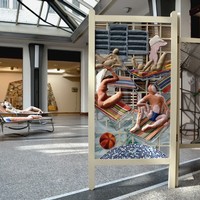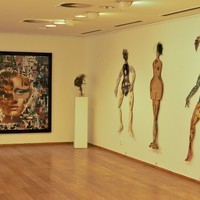Breadcrumbs navigation
Critics' Gallery – Adria Palace (Galerie kritiků - Palác Adria)
This Rondocubist palace with rich sculptural decoration was built from 1923–1924 at the corner of Národní Avenue and Jungmannova Street. The gallery is located on the building's first floor, and its exhibitions are prepared by the Association of Art Critics and Theorists (Sdružení výtvarných kritiků a teoretiků). In addition to exhibitions, it also holds lectures, discussions and other events relating to contemporary art.
- Monuments & Architecture
- palace
- Cubism
- Arts & Entertainment
- gallery
Opening hours
-
- January – December
- Tue, Wed, Thu, Fri, Sat, Sun
- 11.00 – 18.00
Entrance fee
- basic 40 CZK
- reduced 20 CZK
Contacts
- Critics' Gallery – Adria Palace (Galerie kritiků - Palác Adria)
- Jungmannova 31
- 110 00 Praha 1 – Nové Město
- +420224494205
- +420222520676
Object history
Adria Palace
Adria Palace is an important cultural monument of the modern architecture. It was built for Italian insurance company Riunione Adriatica di Sicurtà, which had bought the original two-storey palatial residence at this place in about 1910. The palace here had been built 100 years earlier by Passau Bishop Leonard Leopold Count Thun. The building was decorated with statues sculpted by Josef Malínský.
The insurance company demolished the old palace and in 1923 - 1924 carried out the construction of a new palace, spreading on the area of over 2,000 square meters. The building was designed by architect Josef Zasche; for the façade implementation a new colour scheme by architect Pavel Janák in the rondocubism style (Czech Cubist style using arcs) was selected. The building faces the shorter side to Národní třída, with the terrace on the first floor; longer facade faces Jungmannova Street. The building has a reinforced concrete frame with brick infill walls, 8 above-the-ground and 3 underground floors. The facade is architecturally very much divided. The upper floors are depicted in the form of massive towers with battlements, which resemble Italian Renaissance palaces and a citadel at the same time. Le Corbusier described the building as "a massive construction of the Assyrian character." Later the architect Zasche completed his project with the cinema in the basement and solved the inner disposition of the palace with a central hall and passages. The passage has a form of the circular gallery in the bend of the wings and the vestibule with the glass ceiling. The passage interior is luxurious: Austrian pink-brown marble panelling, gleaming brass on the walls, fixtures and chandeliers. On the floor there is marble mosaic in the then usual colour combination of red-blue-white.
The sculptural decoration
On the ground floor and mezzanine of the premises intended for commercial purposes there are large glassed windows separated by pillars. The terrace leading to Národní třída is decorated with marble statues of girls by Otto Gutfreund; a portal to Jungmannova Street is decorated with marble statues of Mariner and Reaper by Karel Dvořák, the second floor façade is also decorated with neoclassical marble sculptures bigger than life by Bohumil Kafka: they represent Merkur, Perun, Demeter and Park.
At the centre of the facade to Národní třída neo-classicist metal Adria sculpture (Sailing - Mořeplavba) by Jan Štursa is located on a ledge sill. There is no documentation of the sculpture, so the exact name is unknown. The sculpture was created in 1927 according to the Štursa´s model by his pupils. It is probably the biggest galvanoplastic statue in the world, its technology is unique. It was made in a special institute in Geislingen, Germany. It is 5 meters high and weighs 3-4 tons, while its precision is exceptional.
Clock in the hall is decorated with sculptures by Bohumil Kafka: Day and Night, Sun and Moon, and 12 sculptures of the zodiac. The sculptures were cast by František Anýž.
Occupants
There were cafes in the building, in the 1930s such as the well -known Reunion café and textiles shops by the well-known manufacturer Barhoň. In 1946 the building was managed by Slavie Insurance Company and from 1957 there was a film club there; from 1959 the institute of cosmetics was operated on the first floor. From 1958 to 1959 the cinema was adapted for a study stage of the National Theatre called Laterna Magica (architects František Čubr, Josef Hrubý and Zdeněk Pokorný), followed by Theater beyond the Gate (Divadlo Za branou) of Otomar Krejča. In November 1989, the headquarters of the Civic Forum worked here and today it is the home theatre scene of Divadlo Bez zábradlí of Karel Heřmánek.
Reconstruction
In 1996 - 1998 the whole palace was reconstructed. During the reconstruction unfortunately original paternoster lifts were replaced by contemporary ones; also ceiling lowering for the distribution of technical cables and some other steps did not help the palace. A special procedure, however, was used to repair and clean unique façade. All the plastic components including monumental sculpture by Štursa, which had been almost beyond repair, were repaired and reconstructed. After reconstruction (architectural design by Jiří Jiroutek) Adria Palace currently has 5,000 m2 office space, 2,000 m2 of commercial space and 1,500 m2 of restaurant operations. The palace is owned by the Capital City of Prague.
Information source: Galerie Kritiků









